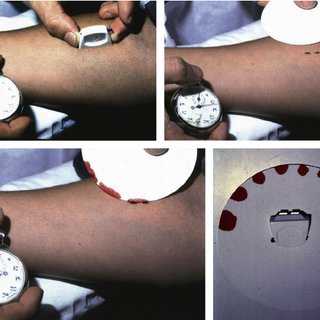The bleeding time is an outdated screening test that was used to measure platelet function and vascular integrity. Under controlled conditions an incision was made in the skin with a modified template device and the duration of bleeding was measured.
The bleeding time was a highly operator–dependent test, plagued by a lack of clinical reproducibility, and affected by numerous technical factors such as location of the incision, pressure applied, operator experience, and patient factors such as age, gender, diet, hematocrit, skin laxity and medications.
Abundant evidence proved that the bleeding time was not reliable as a screening test for peri-operative bleeding or as a diagnostic test for bleeding disorders. Almost every laboratory has discontinued the Bleeding Time.
The best pre-procedure screen to predict bleeding is a careful clinical history including family, dental, obstetric, surgical, traumatic injury, transfusion, and drug history. If the history yields no suspicion of a hemostatic problem, further testing is not warranted.
If the history is positive for a bleeding diathesis, the most common hemostatic disorders can be ruled out by performing screening tests of coagulation (PT and APTT), a platelet count, and ruling out von Willebrand’s disease (Factor VIII, von Willebrand Factor Antigen, Ristocetin Cofactor). If these tests are negative the possibility of a platelet function disorder can be investigated by performing an automated platelet function test or platelet aggregation testing.
References
Gewirtz AS, Miller ML, KeysTF. The clinical usefulness of the preoperative bleeding time. Arch Pathol Lab Med. 1996;120:353- 356.
Powers P, et al. The Preoperative Bleeding Time Test Lacks Clinical Benefit: College of American Pathologists and the American Society of Clinical Pathologists’ Position Article. Arch Surg.1998;133:134-39
Lind SE. The bleeding time does not predict surgical bleeding. Blood.1991;772547- 2552.
Göbel U, et al. The reproductiveness of bleeding time tests. Minerva Pediatr. 1978;301391- 1396.
Lehman CM et al. Discontinuation of the bleeding time test without detectable adverse clinical impact. Clin Chem 2001; 47: 1204-1211.




 How to resolve AdBlock issue?
How to resolve AdBlock issue?